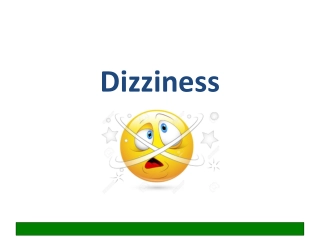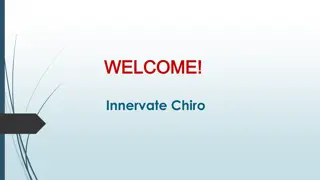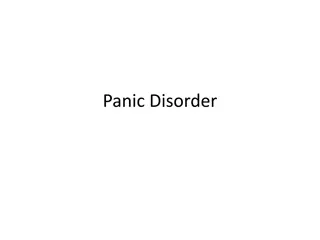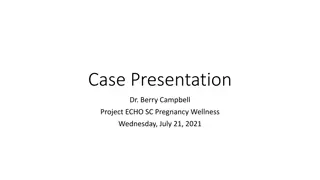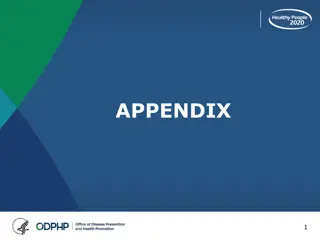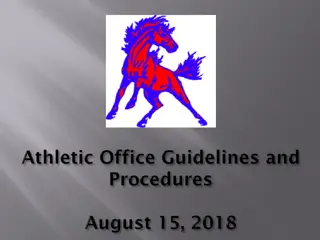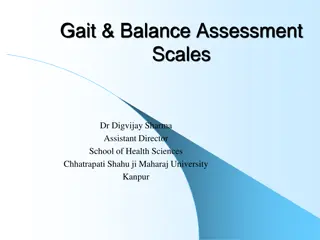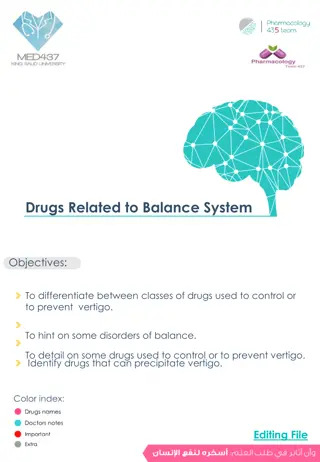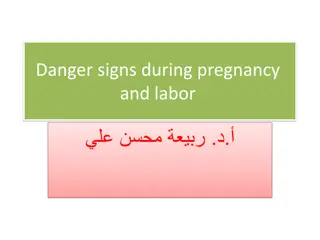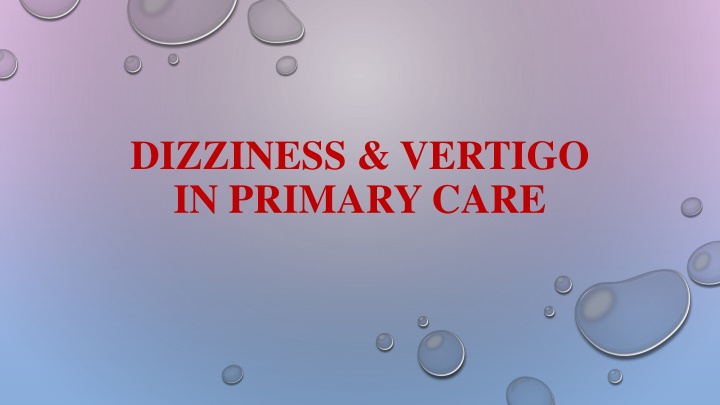
Dizziness and Vertigo in Primary Care: Case Study Analysis
Explore the differential diagnosis, history-taking, clinical examination, and treatment approach for a case of dizziness and vertigo in primary care, featuring a 41-year-old female patient with recurrent episodes. Learn about the importance of balance in maintaining health and the key factors contributing to dizziness.
Download Presentation

Please find below an Image/Link to download the presentation.
The content on the website is provided AS IS for your information and personal use only. It may not be sold, licensed, or shared on other websites without obtaining consent from the author. If you encounter any issues during the download, it is possible that the publisher has removed the file from their server.
You are allowed to download the files provided on this website for personal or commercial use, subject to the condition that they are used lawfully. All files are the property of their respective owners.
The content on the website is provided AS IS for your information and personal use only. It may not be sold, licensed, or shared on other websites without obtaining consent from the author.
E N D
Presentation Transcript
DIZZINESS & VERTIGO IN PRIMARY CARE
Objectives: 1. Explain the patho-physiology of human balance system 2. Compare and contrast dizziness and vertigo 3. Recognize the common causes of dizziness / vertigo 4. Take an adequate history from a dizzy patient 5. Perform Hallpike and Epley's manoeuvres on a dizzy patient 6. Identify the RED flag and ask for appropriate lab investigation in a dizzy patient 7. Justify the differential diagnosis of dizziness 8. Discuss the available therapeutic options at primary care level and criteria for referral to the secondary care
Case scenario: A 41-year-old female came to your clinic after unsuccessful and unusual evaluation and treatment for dizziness elsewhere. She stated that in the summer of 2018, she had experienced brief episodes of dizziness, which disappeared in about 1 month without treatment. In May of 2019, she experienced a recurrence of the symptoms. Her dizzy spells had never lasted more than a few seconds and had always been precipitated by motions such as rolling over in the bed to the left and getting out of bed in the morning. She stated that her symptoms had not varied from the first one.
Neurologic evaluation within our clinic demonstrated normal mental status, language, blood pressure, and cranial nerve function. There was some mild, direction- fixed, right-beating positional nystagmus with eyes closed and alerting in the supine, head-left, and head-hanging positions. The dix-Hallpike maneuver demonstrated a classic response in the head- hanging-left position, the response consisted of paroxysmal, clockwise nystagmus, which began approximately 5 seconds after assuming the position .The response was accompanied by the patient's report that she was dizzy and that the sensation duplicated the spells she had been having.
What is the differential diagnosis for this case? What further questions in the history? What clinical examination you will perform? Are there need for any investigations? What is your approach to help her? What is the maneuver shown to abate this condition?
Balance Correct balance requires: Accurate sensory information from the eyes, proprioceptive receptors (in the joints) & vestibular labyrinth. Accurate coordination of the sensory input by the brain. Functional motor output from the CNS to a normal musculoskeletal system
Dizziness Is a non-specific term which can be categorized into four different subtypes according to symptoms described by the patients. Presyncope: the sense of impending faint, caused by a reduced total cerebral perfusion Light-headedness: often described as giddiness or wooziness Disequilibrium: a feeling of unsteadiness or imbalance when standing
Vertigo: Vertigo is the hallucination of movement of the environment around the patient, or of the patient with respect to the environment. It is not a fear of heights. Vertigo is not necessarily the same as dizziness
Classification: Vertigo may be classified as: Central - due to a brainstem or cerebellar disorder Peripheral - due to disorders of the inner ear or the vestibulocochlear (viiith)cranial nerve
Incidence/prevalence Studies into dizziness indicated that around 30% of patients were found to have vertigo, rising to 56.4% in an older population A GP can therefore expect between 10-20 patients with vertigo in one year 93% of primary care patients with vertigo have either benign paroxysmal positional vertigo (BPPV), acute vestibular neuronitis, or m ni re's disease.
Causes of vertigo: Vertigo with deafness Vertigo without deafness with intracranial signs Vestibular neuronitis Cerebellopontine angle tumour M ni re s disease Labyrinthitis Benign positional vertigo (BPV) CVD : TIA / CVA Labyrinthine trauma Acute vestibular dysfunction Vertebro-basilar insufficiency and thromboembolism: Acoustic neuroma Medication e.g. aminoglycosides Brain tumor Acute cochleo-vestibular Cervical spondylosis Migraine dysfunction Syphilis (rare) Following flexion-extension injury Multiple sclerosis
Common causes in G. Practice: 80% Vestibular Neuritis or BPV 15% Meniere s disease or Vertebrobasilar insufficiency 3% Transient Ischemic Attack (TIA) 1% Ear Infections. 1% Other causes, including Multiple sclerosis, Psychological causes e.g. Anxiety.
Timing of symptoms: The duration of vertigo episodes and associated auditory symptoms will help to narrow the differential diagnosis
Timing of symptoms Associated Auditory Symptoms Duration Of Episode Peripheral or Central Origin Pathology BPPV Seconds No Peripheral Vestibular Neuronitis Days No Peripheral M ni re's Disease Hours Yes Peripheral Perilymphatic Fistula Seconds Yes Peripheral TIA Seconds / Hours No Central
Vertiginous Migraine Vertiginous Migraine Hours No Central Labyrinthitis Days Yes Peripheral Labyrinthitis Stroke Days No Central Stroke Acoustic Neuroma Acoustic Neuroma Months Yes Peripheral Cerebellar Tumour Cerebellar Tumour Months No Central Multiple Sclerosis Multiple Sclerosis Months No Central
PRIMARY CARE GUIDELINES VERTIGO/DIZZINESS Vertigo is defined as an illusion of movement Explore characteristics of symptoms; examine for nystagmus Do a Hallpike test in all patients presenting with vertigo/dizziness At every stage, explore red flags and refer as necessary Dizziness with pre syncopal symptoms should be referred to cardiology Exclude orthostatic/Postural hypotension Consider migraine & treat if appropriate.
Vestibular neuritis One of the commonest causes of true vertigo. Age of onset is 40 years (range 20-60) Is due to temporary lesion of the vestibular nerve
Clinical features Vertigo, usually severe. Absence of cochlear symptoms deafness & tinnitus Absence of neurological symptoms.
Vertigo comes suddenly and without warning, it is continuous, it lasts for about 6 weeks. Head movement may worsening symptoms 90% of patients have nausea 55% have vomiting 70% have nystagmus In 43% attacks are recurrent, each successive recurrent is milder than the one before. In 45% the attack is preceded by infectious illness.
Treatment Partly by vestibular sedation & partly by the brain compensation. Explanation and reassurance are an important part of management. This is a frightening condition, many patients fear a more severe cause for the symptoms. - Prochlorperazine in a dose of 5 mg three times a day. - S/E a Parkinson s like syndrome on chronic use.
Compensation In time the brain adjusts to the distorted information it is getting from the labyrinthine, this process can be accelerated by doing exercises, Eye, head & shoulder movement can be used Standing and walking with the eyes closed also stress labyrinthine function
Habituation techniques Avoid quick spins or movements that provoke vertigo. Sleep in a semi-recumbent position for the next two nights following the above technique. In most cases a recliner works well, or stacking pillows at the head of the bed. Avoid sleeping on the affected side. Try to keep the head upright during the day, avoid all supine activities. After a week of being conservative, start to place the head (in controlled environments) in vertigo provoking positions.
Benign paroxysmal positional vertigo (BPPV) is the most common cause of vertigo, which is a symptom of the condition. Though not fully understood, BPPV is thought to arise due to the displacement of otoconia (small crystals of calcium carbonate) from the maculae of the inner ear into the fluid-filled semicircular canals. These semicircular canals are sensitive to gravity and changes in head position can be a trigger for BPPV. The posterior canal is the most commonly affected site.
BPV Affects an older age group (5th. Decade onwards) A round 25% of dizziness cases have BPV.
Risk factors include: Female sex hypertension (HTN) hyperlipidemia cerebrovascular disease menopause allergies migraine chronic obstructive pulmonary disease (COPD) surgical procedure such as a cochlear implant infection
Clinical features:- Brief severe episodes of vertigo lasting less than a minute, The vertigo provoked by sudden changes of head position, The reaction decays, so that repeating the movement causes less vertigo.
Other symptoms of BPPV include:- Light headedness Loss of balance Nausea Vomiting Nystagmus with positional change of the head
Associated co-morbidities Meniere's disease vertebral basilar insufficiency migraine multiple sclerosis infection: sinus or ear thyroid problems reduced bone mineral density sudden hearing loss
Test Can be performed in general practice, but usually unnecessary since the diagnosis can be obtained from a carful history. Sit the patient on a couch with the head turned to face you. Lower the patient, so that his or her head is over the top edge of the couch & 30% below the horizontal. Nystagmus provoked by this test is always an abnormal finding.
Nystagmus in BPV o Is rotatory, beating towards (i.e. Fast phase) the downward ear, o A latent period of several seconds precedes onset, o Nystagmus abates after a maximum of 50 seconds (adaptation), o Violent vertigo accompanies nystagmus, o On repeating the test, the response diminishes.
Dix-Hallpike test To check for right side involvement, rotate the patient's head to the right 45 degrees while in the long sitting position (this aligns the right posterior semicircular canal with the sagittal plane of the body). The examiner grasp the patient's head and quickly moves the patient to the supine position with the neck slightly extended (ear down position). The examiner checks for nystagmus. If present, note the latency, duration, and direction (should not last more than 1 minute).
Dix-Hallpike test https://www.physio-pedia.com/images/f/f0/Dix-hallpike-c.jpg
Hallpike test Video https://www.youtube.com/watch?v=PQoiX70iuWw
Patient instructions for the Epley maneuver: 1. For the next 2 days and nights, keep your head completely vertical. To sleep, you might sit in a recliner chair, but do not lie all the way back; just far enough to support your head. Support the head by purchasing a neck brace or by pinning two pillows. Avoid any head movements upward or downward for the next week. Do not sleep on the side that generates your dizziness for an additional week. If your right ear is causing the problem, then sleep on your left side.
BPV The symptoms persist for an average of 6 months, then resolve. The underlying cause is the displacement of calcium crystals (otoliths) in the inner ear. Head movement makes the crystals move about, inducing the symptoms.
Treatment Explain the benign nature of the condition, Certain exercises may be used as away of getting the brain to compensate (90% success has been alleged), Prochlorperazine is the commonly prescribed medication. (Common SE is dystonia).
Epley's manoeuvre Patient starts in long sitting with the head rotated 45 degrees to the affected side. Patient next rapidly reclined to the supine position with the neck slightly extended. This position is held for 30 seconds, or until nystagmus and dizziness subside. The patient's head is rotated 90 degrees to the opposite side. This position is held for 20 seconds, or until nystagmus and dizziness subside. The patient's head is turn another 90 degrees, requiring the patient to go from the supine to side-lying position. This position is held for 20 seconds, or until dizziness and nystagmus subside. The patient is brought up to the short-sitting position.
Epley's manoeuvre https://www.physio-pedia.com/images/8/86/Epley-cd.jpg
Epley's manoeuvre Video https://www.youtube.com/watch?v=CPLOd6vqWKI&t=27
Is a disorder of endolymph control, causing dilatation of the endolymphatic spaces in membranous labyrinth. Age of onset is 30-60 years. Both balance & hearing are affected.
Clinical features:- Sudden attacks of severe vertigo, often with prostration and vomiting, Hearing impairment (sensorineural deafness) and tinnitus in the affected ear, Attacks last for a minimum of 10 minutes and a maximum of 12 hours After successive attacks the hearing problem is progressively greater, There is a sensation of pressure in the ear.
Diagnosis Diagnosis is made from the history, apart from the deafness there are no clinical findings between attacks.
Symptoms The timing and duration of the vertigo Provoking or exacerbating factors Associated symptoms such as - Pain - Nausea - Neurological symptoms - Hearing loss
RED FLAGS First attack of vertigo with acute severe headache (REFER TO A/E R/O CVA) Persistent symptoms for > 1 month (REFER TO ENT) Nystagmus lasting > 48 hours (REFER TO ENT) Unilateral tinnitus/dyascusis/aural fullness Sudden/fluctuating hearing loss
RED FLAGS Dysconjugate eye movements Posterior circulation symptoms Positive hallpike test, provoking nystagmus but no symptoms Vertical nystagmus & Cerebellar signs (All these refer to neurology).

